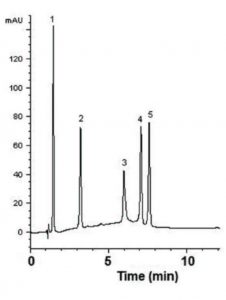Precise and Fast Equilibration Time
HPLC is a technique used for the characterization of Peptides and Reversed Phase HPLC is employed for the initial analysis and final, large scale purification. The first step of the production of Synthetic Peptides usually involves an initial Separation of these compounds from its mixture, on an analytical scale, then purification and collection of the target Peptide follows.
The Figure shown here presents the use of Reversed Phase HPLC Method in the Separation of a five Peptide Mixture. The 300Å pore size of the sorbent is ideal for separation of these Peptides chosen.

Peaks:
1. Gly-Tyr
2. Val-Tyr-Val
3. Methionine Enkephalin
4. Angiotensin II
5. Leucine Enkephalin
Method Conditions
Column: Cogent Bidentate C8 300™, 5µm, 300Å
Catalog No.: 40008-75P-3M
Dimensions: 4.6 x 75mm
Mobile Phase:
—A: DI Water / 0.1% Trifluoroacetic Acid (TFA)
—B: Acetonitrile / 0.1% Trifluoroacetic Acid (TFA)
Gradient:
| Time (minutes) | %B |
| 0 | 9 |
| 5 | 21 |
| 20 | 27 |
| 21 | 9 |
Post Time: 5 minutes
Flow rate: 1.0mL / minute
Detection: UV @ 214nm
Notes: Peptides are distinguished from proteins on the basis of the number of amino acid residues. Generally, this number is about 50 residues or fewer. Because of their smaller size, Peptides do not have the same degree of complexity that proteins do.
Attachment
No 91 Peptide Mixture Separation with HPLC pdf 0.2 Mb Download File


